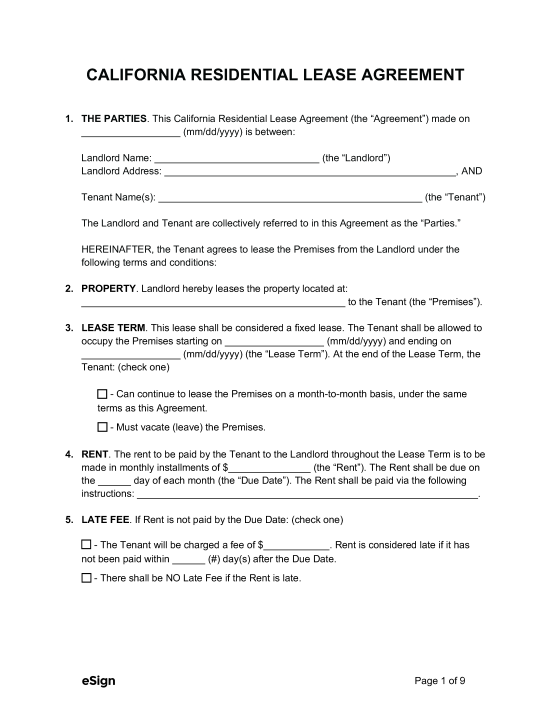Lease Agreements: By Type (6)
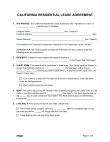 Standard (1-Year) Lease Agreement – The most common residential lease agreement and establishes a one-year tenancy. Standard (1-Year) Lease Agreement – The most common residential lease agreement and establishes a one-year tenancy.
Download: PDF |
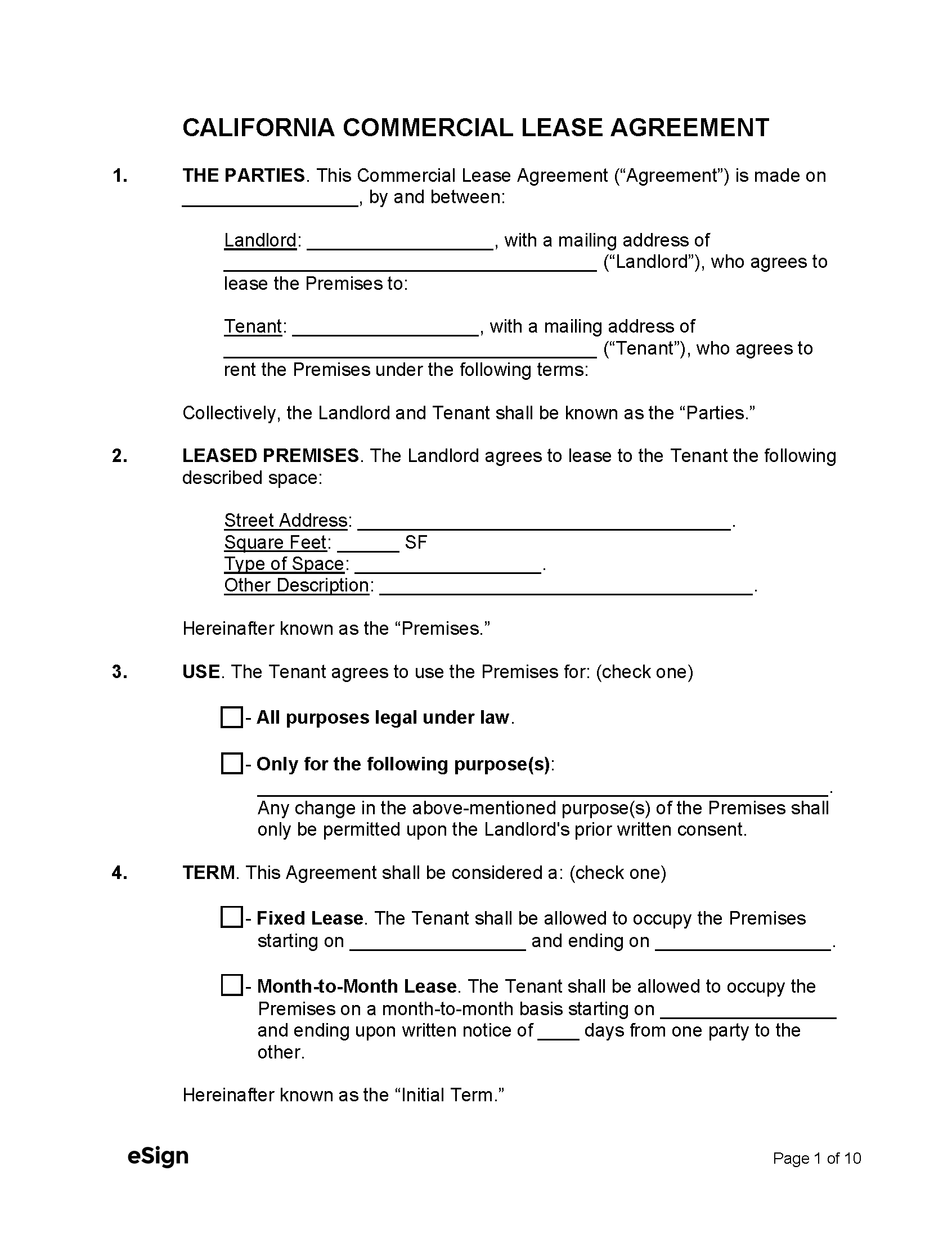 Commercial Lease Agreement – A commercial lease agreement is used to rent an office, industrial, or retail space to a business or individual. Commercial Lease Agreement – A commercial lease agreement is used to rent an office, industrial, or retail space to a business or individual.
Download: PDF, Word (.docx), OpenDocument |
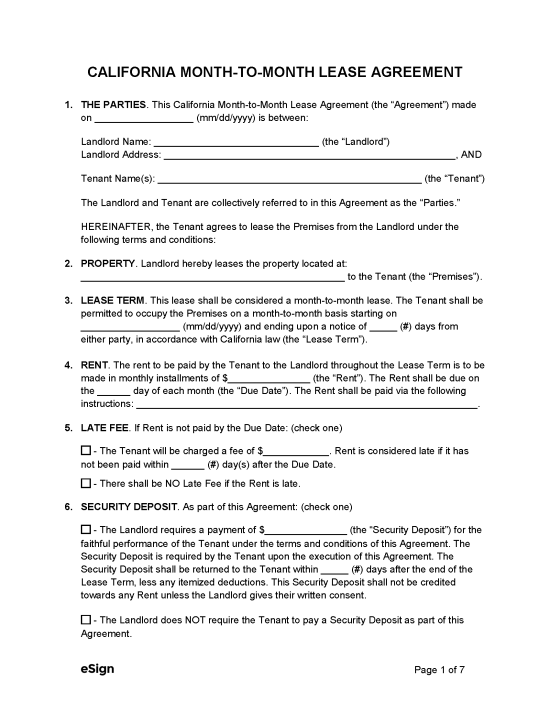 Month-to-Month Lease Agreement – A lease without a specified end date that can be terminated at any time with proper notice. Month-to-Month Lease Agreement – A lease without a specified end date that can be terminated at any time with proper notice.
Download: PDF, Word (.docx), OpenDocument |
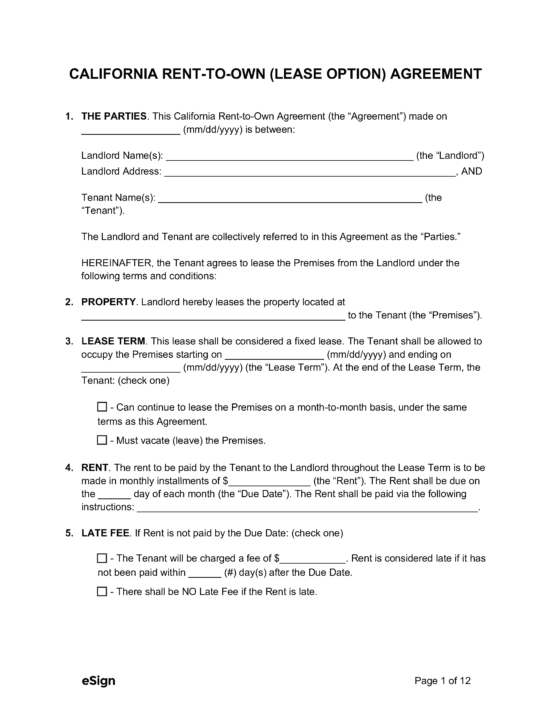 Rent-to-Own Agreement (Lease Option) – This agreement is used to lease a rental unit for a fixed term while allowing the tenant to buy the property under certain conditions. Rent-to-Own Agreement (Lease Option) – This agreement is used to lease a rental unit for a fixed term while allowing the tenant to buy the property under certain conditions.
Download: PDF |
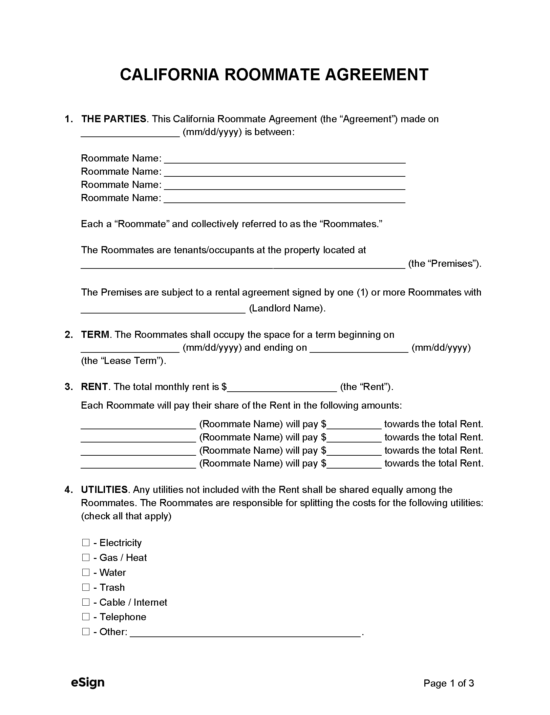 Roommate Agreement – An agreement that establishes rental conditions between roommates who share a residential dwelling. Roommate Agreement – An agreement that establishes rental conditions between roommates who share a residential dwelling.
Download: PDF, Word (.docx), OpenDocument |
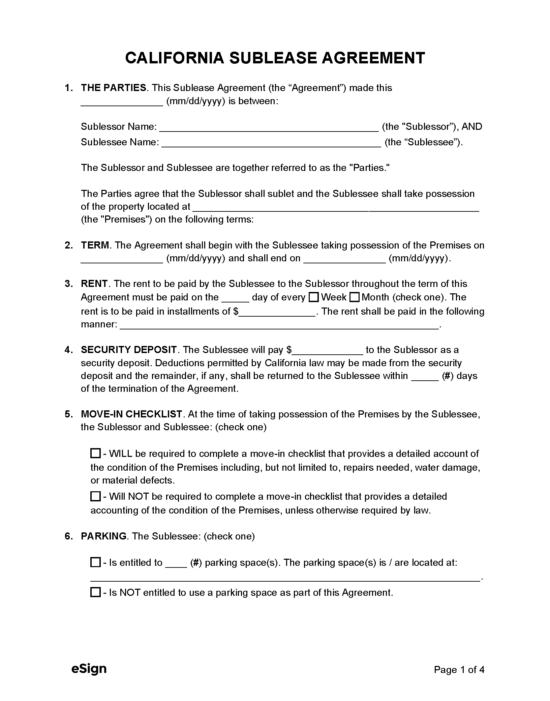 Sublease Agreement – Used by a tenant to rent out a portion or the entirety of their dwelling to another individual. A sublease can only be created with the landlord’s permission. Sublease Agreement – Used by a tenant to rent out a portion or the entirety of their dwelling to another individual. A sublease can only be created with the landlord’s permission.
Download: PDF, Word (.docx), OpenDocument |
Required Disclosures (15)
- AB 1482 Just Cause Addendum (PDF) – Required if certain conditions exempt the property from the just cause and rent increase laws outlined in the California Civil Code.[1]
- Bed Bug Disclosure (PDF) – Landlords must provide tenants with written information concerning bed bug infestations before entering into a lease.[2]
- Death on Premises – If a death occurred in the rental unit, landlords must disclose this to potential tenants. However, disclosure is not required if the death occurred more than three years prior or if the occupant died from AIDS-related complications.[3]
- Demolition – Landlords must notify prospective and current residential tenants if they’ve applied or will apply for a permit to demolish the unit.[4]
- Flood (PDF) – If the property is in a flood hazard area, the landlord must disclose this information to tenants.[5]
- Just Cause – The language outlined in CIV Code § 1946.2(f)(3) must be provided to the tenant if the rental property is subject to the just cause requirements and rent limits imposed by the California Civil Code.[6]
- Lead-Based Paint Disclosure (PDF) – If the rental unit was built before 1978, this form indicating the potential presence of toxic paint on the premises must be signed by both parties.[7]
- Megan’s Law – This notice must be included in every lease to inform prospective tenants that they can perform an internet search for registered sex offenders in their area.[8]
- Methamphetamine Contamination – If the rental property has been contaminated with methamphetamine and is subject to remediation, a copy of the remediation order must be provided to prospective tenants.[9]
- Ordnance Locations – Landlords must notify tenants if the property is in a neighborhood once used as a federal or state ordnance location.[10]
- Pest Control – If a landlord receives periodic pest control services, they must provide new tenants with a copy of the notice issued by the pest control company.[11]
- Shared Utilities – If the unit has a shared electrical or gas meter, landlords must notify tenants of this information and enter into a written agreement to pay these utilities.[12]
- Smoking Policy (PDF) – Any lease agreement containing a non-smoking policy must include a section that informs tenants about the areas around the building where smoking is prohibited.[13]
- Toxic Mold (PDF) – A written disclosure must be provided to tenants whenever mold is on the property. However, the landlord is not obliged to notify prospective tenants if the problem has been remedied.[14]
- Water Submeter Addendum (PDF) – Landlords who charge tenants a separate water bill at a submetered rental property must provide a written billing estimate and explanation of how the charges will be calculated.[15]
Security Deposits
Maximum Amount ($) – Two months’ rent if the unit is unfurnished and three months’ rent if it is furnished.[16]
Collecting Interest – California doesn’t require landlords to pay interest on security deposits, but several rent-controlled cities within the state do. Landlords in rent-controlled cities should check local housing laws for specific interest rates.
Returning to Tenant – The landlord must return a security deposit no later than 21 days after the tenant has vacated the premises.[17]
Itemized List Required? – Yes, an itemized statement outlining the amount and reason for each deduction must be provided to the tenant when their deposit is refunded.[18]
Separate Bank Account? – No, there are no state statutes that require landlords to store security deposits in separate bank accounts.
Landlord’s Entry
General Access – Landlords must provide reasonable notice before entering the rental unit. According to state law, 24 hours’ notice is considered reasonable.[19]
Immediate Access – A landlord may enter a tenant’s dwelling without notice for emergency purposes.[20]
Rent Payments
Grace Period – Unless agreed to in the lease, landlords are not obligated to provide a grace period.
Maximum Late Fee ($) – Not mentioned in state statutes, but late fees should not exceed the reasonable estimate of costs the landlord will incur due to the late rent payment.[21]
Bad Check (NSF) Fee – Landlords can charge a maximum fee of $25 for the first bounced check and $35 for each subsequent one.[22]
Withholding Rent – If the landlord doesn’t keep the property in a livable condition and doesn’t fix the issue within a reasonable timeframe after being notified, the tenant can deduct up to one month’s rent to cover the repair costs.[23] Tenants can also stop paying rent altogether if the landlord doesn’t fix a serious defect that endangers their health and safety.[24]
Breaking a Lease
Non-Payment of Rent – Landlords can provide a 3-day notice if a tenant’s rent is late.[25]
Non-Compliance – Landlords may deliver a 3-day notice (for fixable violations) or a 3-day notice (for unfixable violations).[26]
Tenant Maintenance – Tenants have a legal obligation to maintain the rental unit. If they substantially ignore this responsibility, they’ll be liable for the necessary repairs.[27]
Lockouts – Landlords cannot change the locks to prevent tenants from entering the rental unit.[28]
Leaving Before the End Date – If rent is over 14 days late and the landlord believes that the property has been abandoned, the tenant will be responsible for the unpaid balance, and the lease will terminate automatically.[29]
Lease Termination
Month-to-Month Tenancy – Landlords can use a 30-day notice to terminate a monthly tenancy that’s lasted less than a year, or a 60-day notice if the tenancy has been in effect for one year or longer.[30]
Unclaimed Property – Landlords must provide a notice instructing tenants to retrieve their belongings within 15 days if the notice is hand-delivered or 18 days if it’s sent by mail.[31] Any property left unclaimed will be sold at a public auction. However, the landlord can dispose of or keep the property if the total worth of the tenant’s possessions is under $700.[32]
Sources
- CIV §§ 1946.2(e)(8)(B)(i), 1947.12(d)(5)(B)(i)
- CIV § 1954.603
- CIV § 1710.2(a)(1)
- CIV § 1940.6(a)
- GOV § 8589.45
- CIV §§ 1947.12(d)(5), 1946.2(f)(3)
- EPA/HUD Fact Sheet
- CIV § 2079.10a(a)(3)
- HSC § 25400.28(b)
- CIV § 1940.7(b)
- CIV § 1940.8
- CIV § 1940.9(a)
- CIV § 1947.5(b)(1)
- HSC § 26147
- CIV § 1954.204
- CIV § 1950.5(c)(1)
- CIV § 1950.5(g)(1)
- CIV § 1950.5(g)(1)
- CIV § 1954(d)(1)
- CIV § 1954(e)(1)
- Tenant-Landlord Guide (p. 39)
- CIV § 1719(a)(1)
- CIV § 1942
- CIV § 1942.4(a), Tenant-Landlord Guide (p. 56)
- CCP § 1161(2)
- CCP § 1161(3), (4)
- CIV § 1941.2
- CIV § 789.3(b)(1)
- CIV § 1951.2
- CIV § 1946.1(b), (c)
- CIV §§ 1983, 1984, 1985
- CIV § 1988(a)
